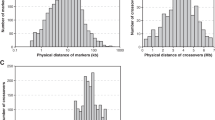Abstract
ASEXUALLY reproducing organisms occur in a variety of taxa in all biological kingdoms1 and distinguishing asexually propagated genotypes is essential for the understanding of their population biology. Among the higher fungi, however, the clonal 'individual' is especially difficult to define2 because most of the fungal thallus consists of a network of anastamosing hyphae embedded in the substratum. Whether fruit-bodies, the most recognizable part of a fungus, are produced by a single supporting mycelium can only be determined by establishing direct physiological continuity or genetic identity. We report a means by which individual fungi can be unambiguously identified within local populations and identify an individual of Armillaria bulbosa that occupies a minimum of 15 hectares, weighs in excess of 10,000kg, and has remained genetically stable for more than 1,500 years.
This is a preview of subscription content, access via your institution
Access options
Subscribe to this journal
Receive 51 print issues and online access
$199.00 per year
only $3.90 per issue
Buy this article
- Purchase on Springer Link
- Instant access to full article PDF
Prices may be subject to local taxes which are calculated during checkout
Similar content being viewed by others
References
Jackson, J. B. C., Buss, L. W. & Cook, R. E. (eds) Population Biology and Evolution of Clonai Organisms (Yale Univ. Press, New Haven and London, 1985).
Rayner, A. D. M. Mycologia 83, 48–71 (1991).
Motta, J. J. & Korhonen, K. Mycologia 78, 471–474 (1986).
Roll-Hansen, F. Eur. J. For. Path 15, 22–31 (1985).
Adams, D. H. Northw. Sci. 48, 21–28 (1974).
Shaw, C. G. III, & Roth, L. F. Phytopathology 66, 1210–1213 (1976).
Dickman, A. & Cook, S. Can. J. Bot 67, 2005–2016 (1989).
Korhonen, K. Karstenia 18, 31–42 (1978).
Ullrich, R. C. & Anderson, J. B. Exp. Mycol. 2, 119–129 (1978).
Guillaumin, J.-J., Anderson, J. B. & Korhonen, K. in Arrnillaria Root Disease (eds Shaw, C. G. Ill & Kile, G. A.) 10–20 (Agricultural Handbook No. 691, US Department of Agriculture, Washington DC, 1991).
Raper, J. R. Genetics of Sexuality in Higher Fungi (Ronald, New York, 1966).
Anderson, J. B., Ullrich, R. C., Roth, L. F. & Filip, G. M. Phytopathology 69, 1109–1111 (1979).
Kile, G. A. Aust. J. Bot. 31, 657–671 (1983).
Ingold, C. T. Fungal Spores, Their Liberation and Dispersal (Clarendon, Oxford, 1971).
Williams, J. G. K., Kubelik, A. R., Livak, K. J., Rafalski, J. A. & Tingey, S. V. Nucleic Acids Res. 18, 6531–6535 (1990).
Smith, M. L., Duchesne, L. C., Bruhn, J. N. & Anderson, J. B. Genetics 126, 575–582 (1990).
Kohn, L. M., Stasovski, E., Carbone, I., Royer, J., & Anderson, J. B. Phytopathology 81, 480–485 (1991).
McDonald, B. A. & Martinez, J. P. Phytopathology 80, 1368–1373 (1990).
Hood, I. A. & Sandberg, C. J. in Proc. 7th Int. Conf. on Root and Butt Rots (ed. Morrison, D. J.) 288–296 (Ministry of Supply and Services, Victoria, British Columbia, 1989).
Frankel, C. Genetics 92, 1121–1126 (1979).
Adams, T. J. H., Williams, E. N. D., Todd, N. K. & Rayner, A. D. M. Trans. Br mycol. Soc. 82, 359–361 (1984).
Buller, A. H. R. Researches on Fungi Vol. 1 (Longmans, Green, London, 1909).
Moody, A. R. & Weinhold, A. R. Phytopathology 62, 264–267 (1972).
Weinhold, A. R. & Garraway, M. O. Phytopathology 56, 108–112 (1966).
Thompson, W. & Boddy, L. New Phytol. 93, 277–291 (1982).
Twery, M. J., Mason, G. N., Wargo, P. M. & Gottschalk, K. W. Can. J. For. Res. 20, 674–678 (1990).
Maniatis, T., Fritsch, E. F. & Sambrook, J. Molecular Cloning: A Laboratory Manual (Cold Spring Harbor Laboratory, New York, 1982).
Anderson, J. B., Bailey, S. S. & Pukkila, P. J. Evolution 43, 1652–1662 (1989).
Rishbeth, J. Trans. Br. mycol. Soc. 51, 575–586 (1968).
Kable, P. F. Trans. Br. mycol. Soc. 62, 89–98 (1974).
Author information
Authors and Affiliations
Rights and permissions
About this article
Cite this article
Smith, M., Bruhn, J. & Anderson, J. The fungus Armillaria bulbosa is among the largest and oldest living organisms. Nature 356, 428–431 (1992). https://doi.org/10.1038/356428a0
Received:
Accepted:
Issue Date:
DOI: https://doi.org/10.1038/356428a0
This article is cited by
-
Fungi anaesthesia
Scientific Reports (2022)
Comments
By submitting a comment you agree to abide by our Terms and Community Guidelines. If you find something abusive or that does not comply with our terms or guidelines please flag it as inappropriate.



